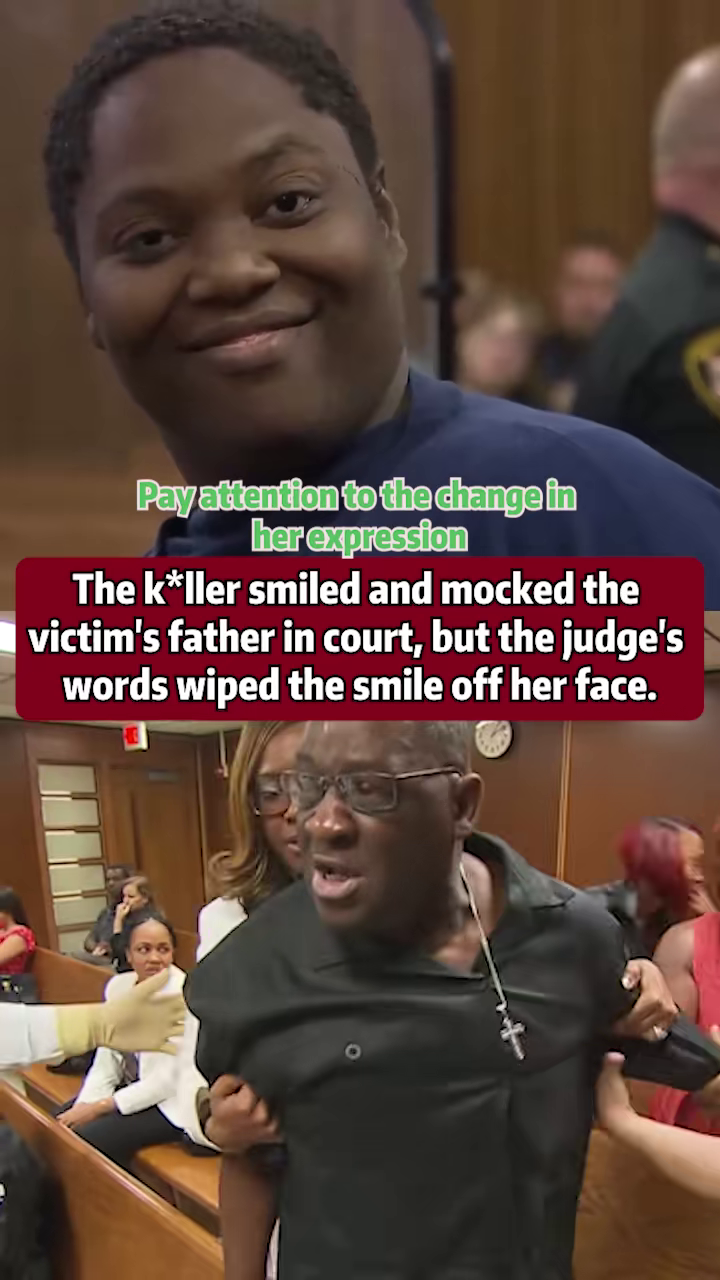In a courtroom charged with unbearable tension, where grief collided with justice and every eye was fixed on the woman accused of committing an unspeakable crime, a chilling moment unfolded that left the entire room stunned, as the convicted killer, seated in chains and awaiting her sentencing, turned her head toward the grieving father of her victim and, in a gesture that cut like a knife, smiled mockingly, her lips curling into a smirk that seemed to revel in cruelty, provoking gasps from those present and tears of rage from a family already broken by loss; the father, his body trembling, had moments earlier delivered a victim impact statement that poured raw emotion into the courtroom, recounting the agony of losing his child, the sleepless nights haunted by nightmares, and the unfillable void left in his heart, his voice cracking as he begged the court to impose the harshest penalty allowed by law, but even his courage could not shield him from the taunting smirk of the woman who had stolen his child’s life, a gesture that for many crystallized the depravity and lack of remorse that had defined her throughout the trial; reporters noted the audible sobs and shouts from the gallery as deputies quickly positioned themselves, fearing an outburst from the father or others, but before the situation could escalate, the judge, a seasoned jurist known for his firm command of the courtroom, leaned forward, his eyes fixed on the defendant with a cold, unflinching stare, and delivered words that would pierce through the facade of arrogance she had displayed for months, words that cut through her smile and left her face drained of its mocking bravado; in a voice heavy with both authority and condemnation, the judge recounted the overwhelming evidence of her guilt, the cruelty of her actions, the devastation inflicted upon an innocent family, and the utter absence of humanity she had shown not only in her crime but in her conduct during the proceedings, making clear that her attempt to mock a grieving father would not sway the scales of justice, but rather serve as further proof of her character and her danger to society; as the sentencing was handed down—life behind bars without the possibility of parole—witnesses described the transformation in her demeanor as immediate and striking, her smirk evaporating into a pale, tight-lipped expression, her eyes darting as if searching for an escape from the reality that she would never again walk free, never again manipulate or mock her way through life, and in that instant, the power dynamic shifted entirely, the woman once capable of inflicting terror reduced to silence under the weight of accountability; the father, though still devastated, was seen nodding slowly, his eyes wet with tears but his lips whispering words of gratitude toward the bench, knowing that while his daughter’s life could never be restored, justice at last had been served, and the killer’s cruel smile had been silenced; outside the courthouse, emotions overflowed as community members embraced the victim’s family, reporters clamored for statements, and legal experts weighed in on the unusual but powerful exchange that had defined the closing moments of the trial, many remarking that the killer’s smile may go down as one of the most haunting courtroom images in recent memory, a stark reminder of evil’s ability to flaunt itself even in the halls of justice, but also a testament to the resilience of victims’ families and the power of the judicial system to respond with finality; the case, which had already attracted national attention due to its disturbing details, now spread further across headlines and social media, with images of the courtroom scene circulating widely, sparking conversations not only about the crime itself but also about the strength required for victims’ families to confront those responsible, and the way judges and courts must balance impartial justice with acknowledgment of raw human suffering; psychologists analyzing the scene noted that killers who display smugness or mockery in court often do so as a means of exerting control, attempting to provoke emotional responses from victims’ families as a way to maintain a sense of power, but that such behavior can backfire when met with firm, authoritative condemnation, as it did here, leaving the perpetrator stripped of the very control she sought to wield; for the community still grieving the young life that had been cut short, the sentencing marked both an ending and a beginning—an end to the trial that had consumed their thoughts and prayers, and the beginning of a long journey toward healing, though the scar of what had happened would never fully fade, a permanent reminder of the precious life taken far too soon; vigils have already been planned to honor the victim’s memory, with candles, prayers, and pledges that her light will not be forgotten, that her name will be spoken for generations as a reminder of both tragedy and resilience, while her father has vowed to dedicate his life to advocacy, ensuring that others who face such devastating losses know they are not alone and that justice, though sometimes slow, can prevail; and so, in that courtroom where a killer once smiled in cruelty, it was ultimately the judge’s voice—measured, steady, and unyielding—that carried the final word, erasing her smirk, ending her arrogance, and sealing her fate, a moment that will be remembered not only as the conclusion of a painful trial but as a powerful example of justice rising above cruelty, of dignity defeating mockery, and of a grieving father standing tall even in the face of unimaginable loss.

